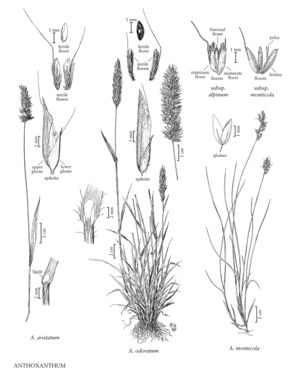Difference between revisions of "Anthoxanthum monticola"
imported>Volume Importer |
imported>Volume Importer |
||
| Line 53: | Line 53: | ||
|publication year= | |publication year= | ||
|special status= | |special status= | ||
| − | |source xml=https:// | + | |source xml=https://bitbucket.org/aafc-mbb/fna-data-curation/src/2e0870ddd59836b60bcf96646a41e87ea5a5943a/coarse_grained_fna_xml/V24/V24_1077.xml |
|subfamily=Poaceae subfam. Pooideae | |subfamily=Poaceae subfam. Pooideae | ||
|tribe=Poaceae tribe Poeae | |tribe=Poaceae tribe Poeae | ||
Revision as of 20:48, 5 November 2020
Plants perennial; densely to loosely cespitose, rhizomes to 2 cm long, rarely longer, about 2 mm thick. Culms 20-55(75) cm. Basal sheaths glabrous, brown to deep purple; ligules 0.2-1.5 mm, truncate, ciliate; blades 1-12 cm long, (0.7) 1-3(5) mm wide, flat or folded, abaxial surfaces glabrous and shiny, adaxial surfaces sparsely scabrous or pilose. Panicles 1-8.5 cm long, 1.2-2 cm wide, with (3)10-20(35) spikelets. Spikelets 5-8 mm, tawny; rachilla internodes about 0.1 mm, glabrous. Glumes subequal, 4.8-6.7 mm, about equal to the lemmas; lowest 2 florets staminate; lemmas 4-6.5(8) mm, moderately hairy, hairs to 1 mm, apices deeply bifid, first lemma awn 0.6-4(6.5) mm, second lemma awn 4.5-10.5 mm, usually geniculate, arising from near the base to near midlength; bisexual lemmas 3.5-5.2 mm, pubescent towards the bifid apices; anthers 1.5-2.7 mm. 2n = 56, 58, 63, 66, 72.
Distribution
Maine, N.H., Alta., B.C., Greenland, Man., Nfld. and Labr., N.W.T., Nunavut, Ont., Que., Yukon, N.Y., Alaska, Vt., Mont.
Discussion
Anthoxanthum monticola is circumpolar, usually growing above or north of the tree line, occasionally in open forests. It occurs sporadically on well-drained, weakly acidic to neutral sand, gravel, and rocky barrens in most of arctic North America; it is not common to the south, even at high elevations. It is facultatively apomictic, but slow to set seed. Revegetation is best accomplished vegetatively. It is listed as threatened or endangered in several parts of its range. There are two subspecies in the Flora region.
Selected References
None.
Key
| 1 | Awns of the upper staminate florets 5-10.5 mm long, attached from near the base to about midlength; awn usually strongly geniculate, the lower portion usually twisted, with 2-4 gyres | Anthoxanthum monticola subsp. alpinum |
| 1 | Awns of the upper staminate florets 4.5-7 mm long, attached at or above midlength, not or only weakly geniculate, the lower portion not twisted or twisted with 1-2 gyres | Anthoxanthum monticola subsp. monticola |
